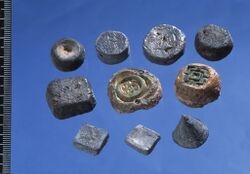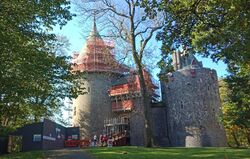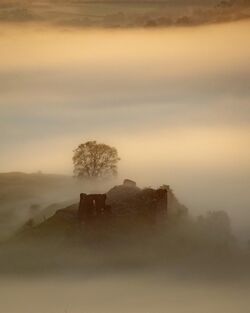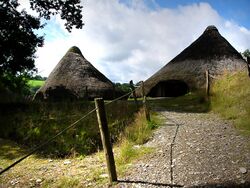Earth:Archaeology of Wales
The Archaeology of Wales is the study of human occupation within the country of Wales, which has been occupied by modern humans since 225,000 BCE, with continuous occupation from 9,000 BCE.[1] Analysis of the sites, artifacts and other archaeological data within Wales details its complex social landscape and evolution from Prehistoric times to the Industrial period. This study is undertaken by academic institutions, consultancies, charities as well as government organisations.
Timeline
Prehistoric Wales
- See Prehistoric Wales
In Palaeolithic times evidence of human activity is scant; this is due in part to geological factors, with deposits being washed away or overridden.[2] From the surviving evidence, human occupation can still be determined, with significant artifacts such as the Red Lady of Paviland, discovered in 1823. Its original discovery resulted in many false theories about its origin, but subsequent re-examinations using increasingly sophisticated technology led to "The Red Lady" (now known to be a male skeleton) being confirmed as the oldest skeleton of a modern human to be discovered in the United Kingdom ,[3][4] dating back 33–34,000 years according to Oxford University's Museum of Natural History.[5]
There is greater Neolithic evidence, including the 150 cromlechs[6][7] found throughout Wales and dolmens such as Pentre Ifan. Settlements are also present in the archaeological record, with a Neolithic neighbourhood in Llanfaethlu being the possible "earliest village" in Wales.[8] Industry is also evident, with a neolithic quarry being recently discovered in St. Dyfnog’s Well.[9][10]
Bronze Age Wales
Around 200 BCE the use of bronze to make tools became common in Wales, superseding copper.[2] During this period, the greatest archaeological evidence of human activity is through artifacts and burial sites, rather than settlement sites.[2] These artifacts include a large frequency of metalwork hoards,[2] such as the Broadward hoard. Such artifacts also demonstrate the metallurgical capacities present in Bronze age Wales, such as the sheet-gold working on the Mold Cape. This industry is also seen at Great Orme, where copper was mined in the largest Bronze age mine in the world[11]
Iron Age Wales
Iron age Wales, from 800 BCE to 74 CE, in comparison with other periods has not been subject to as extensive archaeological excavations.[12] Evidence for the period comes predominantly from settlement and hillfort sites, as well as status items, with artifacts relating to local societies and domestic life being scarce.[12] Of current findings there is evidence of an elite warrior class as well as cross-cultural contact[12]
Roman Wales
- See Wales in the Roman era
Wales was occupied by Rome until 78 CE,[13] leaving many sites throughout Wales that have since been excavated. After conquering the local Celtic tribes of Deceangli, the Ordovices and the Silures, control was solidified through military strength, social assimilation and fortified infrastructure.[2] This includes the South Wales town of Caerleon, known in Roman times as Isca Augusta, with prominent sites such as military barracks, baths, and one of the best-preserved amphitheatres in Britain.[14] Existing settlements in Wales were also subject to romanization, with the population at Tre’r Ceiri, where many Roman artefacts have been found, growing during Roman occupation.[15] Mining also occurred in Roman times, such as within Camarthenshire where archaeological fieldwork and excavation has established complex gold mining[16]
Medieval Wales
The large-scale occupation of Wales by England in the Medieval period is reflected in the archaeological record, particularly in the political architecture of castles. Wales has over 600 castles, many in stone built by the English during or following the Norman conquest.[17] It is consequently known to many as the castle capital of the world.[18][17][19] It is during this period that the various Kingdoms of Wales and later the Principality of Wales formed,[20] both leaving significant archaeological remains.[21] Vikings raids also occurred throughout the Medieval period in Wales, particularly in coastal areas.[22] Archaeological evidence also establishes non-violent interaction between the Norse and Welsh peoples, such as the Viking settlement at Llanbedrgoch.[22]
Industrial Wales to Present
- See Industrial archaeology
Wales had a 400 year period of industrialization, including major industries of stone quarrying, coal and metal mining and smelting among others.[16] These industries have left tangible archaeological remains, such as the Llangollen Canal in North Wales which was used to transport raw materials as well as other products from Wales into England.[23] Many sites from this time are highly preserved, with some such as Blaenavon and Llanberis now housing Industrial museums.[24]
Notable Sites
Pentre Ifan, a Neolithic cromlech, is symbolic of Welsh heritage,[25] called one of Wale’s most well known prehistoric monuments.[26] The site has been studied since 1603 and was likely a communal burial site and sacred space throughout its use.[25] In Anglesey, the Neolithic site of Bryn Celli Ddu which consists of a henge and chambered tomb is also frequently visited.[27][28]
A notable Bronze age site is the Great Orme Copper Mines,[28] which had the capacity to produce nearly 2,000 tons of bronze[29] as the largest mine of its time currently known in the world.[11][29] The site was used throughout the Bronze age before production ceased, and was also briefly mined in the Roman period.[29] The copper produced was used to make bronze objects which were then traded and dispersed throughout Europe.[30]
The iron age fort of Tre’r Ceiri is one of the best preserved and intact site of its kind within the UK.[15][31][32][33] Over time it has been the focus of intense archaeological study,[33] with the earliest evidence for human occupation being a Bronze age cairn. The site was occupied during Roman times, with large amounts of Roman artefacts being excavated. Occupation ended in the 4th century CE however the site is still a major tourist destination.[28][32]
There are several prominent Roman sites that have been excavated in Wales. In North Wales, Segontium is of note, being the largest Roman fort in the area and a big tourist attraction.[28] The site also includes a temple and town. Isca Augusta, modern Caerleon, is a similar military site which also is the location of the National Roman Legion Museum. Another site, Venta Silurum, demonstrates the best preserved Roman defensive walls within the UK.[34]
Offa's Dyke, a medieval earthwork created as a demarcation border between England and Wales[35] and is now a popular walking track.[28] Other popular Medieval sites include Tintern Abbey, Carreg Cennen, and the castles at Conwy, Caerphilly, Caernarfon, Cardiff and Pembroke.[28]
There are three UNESCO World Heritage Sites relating to archaeology within Wales, meeting UNESCO's criteria of Outstanding Universal Value: Pontcysyllte Aqueduct and Canal, The Castles and Town Walls of King Edward in Gwynedd and Blaenavon Industrial Landscape.[36] The Castles and Town Walls of King Edward constitute of a number of medieval sites,[37] while Poncysyllte and Blaenavon are examples of industrial sites, with Blaenavon receiving 113,324 individuals to the Big Pit National Coal Museum within the site between 2019-2020.[38]
Institutions
There are many institutions involved with archaeology in Wales. Cadw is the government agency responsible for the historic environment of Wales, involved with caring for and up-keeping historic sights while also encouraging public access and engagement. They are also responsible for promoting archaeological research throughout Wales, such as their support for excavations at Dryswlyn Castle.[39] Another government body is the Royal Commission on the Ancient and Historic Monuments of Wales (RCAHMW), which by Royal Warrant collects, maintains and distributes archaeological and historic information as well as responsibilities over national standards on these topics.[40]
Charities are also involved in Welsh archaeology, such as the four Welsh Archaeological Trusts. This includes the Clwyd-Powys Archaeological Trust, Dyfed Archaeological Trust, Glamorgan-Gwent Archaeological Trust and Gwynedd Archaeological Trust; with each trust focusing on their respective region to help manage, promote and educate on archaeology.[41] The Council for British Archaeology Wales Cymru is the Welsh branch of a UK wide charity, involved in supporting archaeologists and promoting heritage in Wales, such as through their initiative the Young Archaeologists club.[42][43][44] Another notable charity is the Cambrian Archaeological Association, which studies and educates on Welsh archaeology as well as publishing a yearly journal, Archaeologia Cambrensis.[45]
Universities in Wales that include courses on archaeology include University of Wales Trinity Saint David, Bangor University, Swansea University, Aberystwyth University and Cardiff University[46]
- Big Pit National Coal Museum
- Blaenavon Ironworks
- Brecknock Museum & Art Gallery
- Caerleon Roman Fortress and Baths
- Castell Henllys
- Ceredigion Museum
- Cosmeston Medieval Village
- Dolaucothi Gold Mines
- Gower Heritage Centre
- Kidwelly Industrial Museum
- Llancaiach Fawr
- National Museum Cardiff
- National Roman Legion Museum
- National Waterfront Museum
- Radnorshire Museum
- Rhondda Heritage Park
- Segontium
- St Fagan's National Museum of History
- Strata Florida Abbey
- Swtan Heritage Museum
- Sygun Copper Mine
- Tenby Museum and Art Gallery
Public Engagement
Around Wales a variety of museums, organisations and charities help promote archaeology to the public. This includes access to many sites, monuments and museums, such as the 121 sites Cadw manages.[47] Public engagement is also encouraged by reenactment or living history demonstrations and museums, such as Castell Henllys, a reconstructed iron age hillfort, or the St Fagans Folklore Museum, a museum which recreates various aspects of Welsh history, with the later receiving 683,613 visitors between 2018/19.[48] Similar sites include Cosmeston Medieval Village, a 14th century living history museum. Accessibility is also improved with free online heritage databases, such as Coeflin or Archwilio, run by the Royal Commission on the Ancient and Historic Monuments of Wales and the Welsh Archaeological Trusts respectively.
The Council for British Archaeology hosts a Festival of Archaeology, which includes events in Wales.[49] Other organisations have also hosted archaeological days, such as the Pembrokeshire Coast National Park Archaeology Day[50]
Volunteer community projects, such as the Chirk Castle Community Archaeology Project also encourage public engagement in archaeology throughout Wales.
References
- ↑ "BBC - Wales - History - Themes - Chapter one: Prehistoric Wales". https://www.bbc.co.uk/wales/history/sites/themes/guide/ch1_prehistoric_wales.shtml.
- ↑ 2.0 2.1 2.2 2.3 2.4 Stanford, S. C. (1980). The archaeology of the Welsh Marches. London: Collins. ISBN 0-00-216251-2. OCLC 6791703.
- ↑ Dodd, A. H. (1972). A short history of Wales : Welsh life and customs from prehistoric times to the present day. London: B.T. Batsford. ISBN 0-7134-1466-9. OCLC 19629146. https://archive.org/details/shorthistoryofwa00dodd.
- ↑ Moss, Stephen (2011-04-25). "The secrets of Paviland Cave" (in en-GB). The Guardian. ISSN 0261-3077. https://www.theguardian.com/science/2011/apr/25/paviland-cave-red-lady.
- ↑ "The 'Red Lady' of Paviland | Oxford University Museum of Natural History". https://oumnh.ox.ac.uk/red-lady-of-paviland-0.
- ↑ "Cromlech, the first Welsh stone structures" (in en-GB). https://www.historic-uk.com/HistoryUK/HistoryofWales/Cromlech-the-first-Welsh-houses/.
- ↑ "BBC - Wales - History - Themes - Chapter one: Prehistoric Wales". https://www.bbc.co.uk/wales/history/sites/themes/guide/ch1_prehistoric_wales.shtml.
- ↑ Krakowka, Kathryn (2017-10-05). "Wales' earliest village?" (in en-US). https://www.archaeology.co.uk/articles/wales-earliest-village.htm.
- ↑ "Neolithic Quarry Discovered at Christian Pilgrimage Site in Wales - Archaeology Magazine". https://www.archaeology.org/news/8070-191011-wales-neolithic-quarry.
- ↑ "Neolithic era quarry discovered in Wales" (in en-US). 2019-10-31. https://www.quarrymagazine.com/2019/10/31/neolithic-era-quarry-discovered-in-wales/.
- ↑ 11.0 11.1 "Great Orme Copper Mines, History & Photos | Historic Wales Guide" (in en). https://www.britainexpress.com/attractions.htm?attraction=392.
- ↑ 12.0 12.1 12.2 Ritchie, Matt (2018-02-28). "A Brief Introduction to Iron Age Settlement in Wales" (in en). Internet Archaeology (48). doi:10.11141/ia.48.2. ISSN 1363-5387. https://intarch.ac.uk/journal/issue48/2/index.html.
- ↑ "United Kingdom - Roman Britain" (in en). https://www.britannica.com/place/United-Kingdom.
- ↑ Brenda Williams (April 2004). The Romans in Britain. Jarrold Publishing. pp. 74–. ISBN 978-1-84165-127-9. https://books.google.com/books?id=WpLL9akraBAC&pg=PA74.
- ↑ 15.0 15.1 "Tre'r Ceiri Hillfort" (in en). https://museum.wales/iron_age_teachers/hillforts/tre_ceiri/.
- ↑ 16.0 16.1 Rees, Morgan (1975). The industrial archaeology of Wales. David & Charles. ISBN 0-7153-6819-2. OCLC 493251105.
- ↑ 17.0 17.1 "Castles in Wales" (in en). 2019-01-22. https://www.wales.com/about/culture/castles.
- ↑ "Castles everywhere" (in en). https://www.visitwales.com/things-do/attractions/castles-heritage/wales-castle-capital-world.
- ↑ "Wales – the Castle Capital of the World" (in en-US). 2014-04-01. https://www.tenontours.com/wales-the-castle-capital-of-the-world/.
- ↑ "Early Medieval Wales". http://www.castlewales.com/medwales.html.
- ↑ Steane, John (2014-10-30). The Archaeology of Medieval England and Wales. doi:10.4324/9781315746975. ISBN 9781315746975.
- ↑ 22.0 22.1 "When the Vikings invaded North Wales" (in en). https://museum.wales/articles/2007-04-02/When-the-Vikings-invaded-North-Wales/.
- ↑ "Llangollen Canal & Horseshoe Falls" (in en-gb). https://www.llangollen.org.uk/index.php/things-to-do/history/industrial-revolution/item/46-llangollen-canal-horseshoe-falls.
- ↑ "Industrial Wales | Cadw" (in en). https://cadw.gov.wales/learn/sites-through-centuries/industrial-wales.
- ↑ 25.0 25.1 "Pentre Ifan Burial Chamber | Historic Pembrokeshire Guide" (in en). https://www.britainexpress.com/attractions.htm?attraction=402.
- ↑ Hayward, Will (2018-10-09). "One of Wales' most famous prehistoric sites has been vandalised". https://www.walesonline.co.uk/news/wales-news/one-wales-most-famous-prehistoric-15254036.
- ↑ "Bryn Celli Ddu Burial Chamber | Cadw". https://cadw.gov.wales/visit/places-to-visit/bryn-celli-ddu-burial-chamber.
- ↑ 28.0 28.1 28.2 28.3 28.4 28.5 Dragicevich, Peter (April 2017). Wales. McNaughtan, Hugh,, Lonely Planet Publications (Firm) (6th ed.). [Footscray, Victoria, Australia]. ISBN 978-1-78657-330-8. OCLC 981257208.
- ↑ 29.0 29.1 29.2 "The World's Largest Prehistoric Copper Mine" (in en). http://www.atlasobscura.com/places/the-great-orme-copper-mines.
- ↑ "Welsh Mine Supplied Copper to Bronze Age Europe - Archaeology Magazine". https://www.archaeology.org/news/8144-191030-wales-copper-mine.
- ↑ "Tre'r Ceiri - hillfort" (in en-GB). https://medievalheritage.eu/en/main-page/heritage/wales/trer-ceiri-hillfort/.
- ↑ 32.0 32.1 "Tre'r Ceiri Hillfort - History, Travel, and accommodation information" (in en). https://www.britainexpress.com/attractions.htm?attraction=4670.
- ↑ 33.0 33.1 Driver, T. (2008-08-06). "TRE'R CEIRI HILLFORT, LLANAELHAEARN". https://coflein.gov.uk/en/site/95292/details/trer-ceiri-hillfort-llanaelhaearn.
- ↑ "Roman Sites and Roman Remains in Britain" (in en-GB). https://www.historic-uk.com/HistoryMagazine/DestinationsUK/RomanSites/.
- ↑ "Offa's Dyke | English history" (in en). https://www.britannica.com/topic/Offas-Dyke.
- ↑ "The 3 Welsh World Heritage Sites |". https://www.pontcysyllte-aqueduct.co.uk/world-heritage-status/unesco-and-other-sites-in-wales/.
- ↑ Centre, UNESCO World Heritage. "Castles and Town Walls of King Edward in Gwynedd" (in en). http://whc.unesco.org/en/list/374/.
- ↑ "Cumulative Visitor Figures: 2019-2020" (in en). https://museum.wales/visitor-figures/cumulative-2019-20/.
- ↑ Caple, Chris. Excavations at Dryslwyn Castle 1980-1995.. ISBN 978-1-351-19487-7. OCLC 1011120783.
- ↑ here, add publisher (2015-06-23). "The Royal Commission on the Ancient and Historical Monuments of Wales". https://law.gov.wales/culture/historic-environment/royal-commission-ancient-monuments-wales/?lang=en#/culture/historic-environment/royal-commission-ancient-monuments-wales/?tab=overview&lang=en.
- ↑ "The Welsh Archaeological Trusts Code of Practice for provision of Archaeological Advice 2017". http://www.ggat.org.uk/archplan/downloads/The%20Welsh%20Archaeological%20Trusts%20Code%20of%20Practice%20for%20Archaeological%20Advice%202017.pdf.
- ↑ Club, Young Archaeologists'. "Donate to the YAC - Archaeology for you". http://www.yac-uk.org/donate-to-the-yac.
- ↑ "The Council for British Archaeology (CBA) and You | The Post Hole". https://www.theposthole.org/read/article/313.
- ↑ "CBA WALES" (in en). https://councilforbritisharchaeologywales.wordpress.com/.
- ↑ "Cambrian Archaeological Association – One of the oldest societies in Wales and the Marches devoted to the study of the history and archaeology of the Principality." (in en-US). https://cambrians.org.uk/.
- ↑ "5 institutions in Wales | offering Archaeology courses" (in en). https://www.hotcoursesabroad.com/study/training-degrees/wales/archaeology-courses/loc/77/cgory/i1-3/sin/ct/programs.html.
- ↑ "Find a place to visit | Cadw". https://cadw.gov.wales/visit/places-to-visit/find-a-place-to-visit/map.
- ↑ "Cumulative Visitor Figures: 2018-2019" (in en). https://museum.wales/visitor-figures/cumulative-2018-19/.
- ↑ "Find events | Festival of Archaeology". https://festival.archaeologyuk.org/find.
- ↑ Park, Pembrokeshire Coast National. "Annual Archaeology Day" (in en). https://www.pembrokeshirecoast.wales/default.asp?PID=531.






